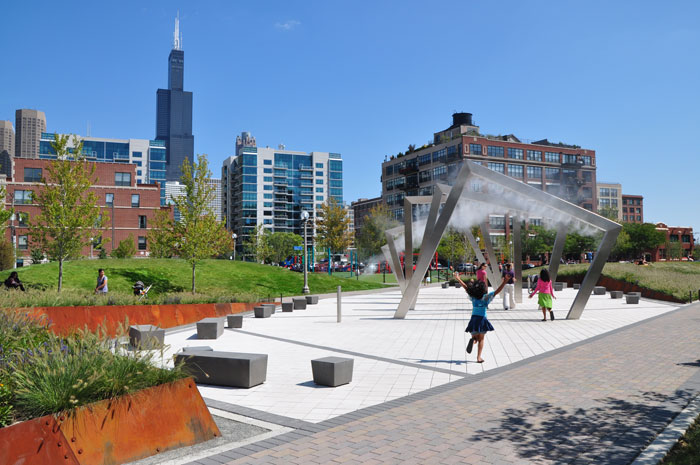As a landscape architect, Kaia Nesbitt is always prepared to discuss the latest developments in park design. If asked about trends, though, she sees a teachable moment and kindly suggests that trend spotting ought not to be the purpose of the discussion. That’s because whatever happens to be trending isn’t her guiding principle when it comes to design. Instead, “I engage in a process that’s less about trend identification and more about responding to each community’s specific needs”—an approach informed by her background in “human-centered design,” she said.
With that said, Nesbitt added that climate concerns, shrinking capital budgets and pandemic-related societal shifts have
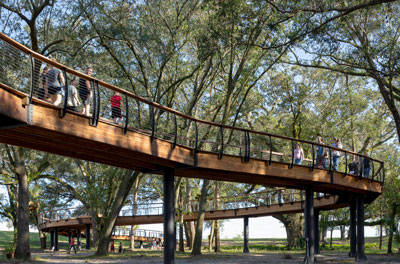
given rise to three needs that are consistent among the communities she serves as the director of urban design, planning and landscape architecture at HDR Inc., a global firm based in Omaha, Neb.
And sure enough, when Recreation Management asked other firms which of their projects reflected the latest and greatest in park landscape design, the ones they chose had planning and design components that went a long way toward addressing those very same needs:
- Responding to climate change: Parks are a critical component in the creation of climate-resilient communities.
- Alleviating social disconnection: The need is so severe and widespread that the U.S. Surgeon General issued a 2023 advisory titled “Our Epidemic of Loneliness and Isolation.”
- Doing more with less: Fiscal constraint in local government increases competition among different public services for tax funds, so parks and recreation programs are faced with the challenge of stretching resources or finding alternative funding sources.
Parks as Protectors of the Environment
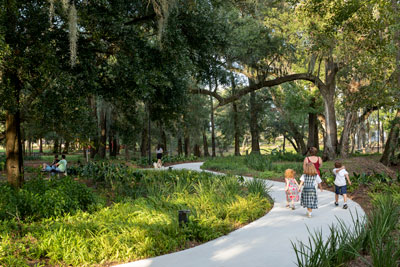
The primary purpose of park design is to provide opportunities for recreation, but it’s not the sole purpose—particularly
when it comes to landscaping. With climate concerns persisting if not worsening, parks with integrated water-management solutions and ample softscaping can help mitigate urban flooding, water scarcity and the heat island effect. Such parks behave like sponges, or reservoirs for capturing, filtering and in some cases reclaiming stormwater for irrigation.
Rain gardens consisting of native and adapted vegetation are a tried-and-true method of draining and cleaning rainwater before it moves offsite. Nowadays, landscape architects commonly work with hydrologists to develop water-management solutions that surpass the average bioretention facility in emulating natural hydrological processes, resulting in improved groundwater recharge and less pressure on storm drains.
Though well aware of the important role parks play in stormwater management, landscape architects in the recent past “used to try to conceal this function of the park rather than showcasing it,” said Hana Ishikawa, design principal at Site Design Group, a Chicago-based landscape architecture and urban design firm. “Now, we deliberately allow for space where water can collect and build up for a while after a big rain event so people can watch as it slowly drains and start to understand this part of the water cycle.”
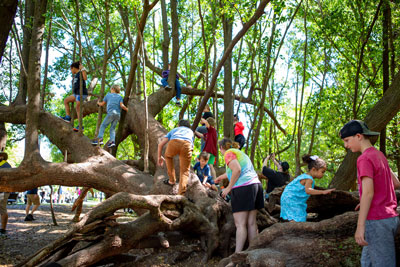
This represents a shift toward “eco-revelatory design,” Nesbitt said, and it’s on full display at Rodney Cook Sr. Park, an
HDR-led project in Atlanta’s Vine City neighborhood, where an overabundance of impervious surfaces had caused severe flooding in the past. The 16-acre park is designed to store up to 10 million gallons of stormwater runoff, in such a way that “the ecology and the movement of water—how it surges and flows and filters through plants—is revealed visually and experientially,” with educational placards further explaining the park’s dual-purpose role as a watershed management project, as well as a recreation space complete with walking paths, picnic areas, a playground, a splash pad, basketball and multipurpose courts, and outdoor workout stations.
Climate-resilient park design often incorporates subtle or overt educational components, including outdoor classrooms in some cases, to teach the public about the park’s sustainable features, ecology and natural history. In no way are these design elements “force feeding” environmental education to the public; rather, they satisfy the stated needs and desires of surrounding communities yearning to be closer to nature.
Parks as Portals to Nature
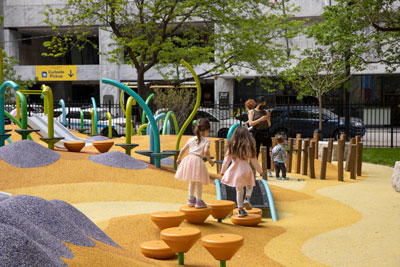
When soliciting community input as part of the park planning process, landscape architects at RDG Planning & Design often find that “the majority of the responses reveal that people want to engage with or actually be challenged by elements of nature,” said RDG Principal Scott Crawford, who leads the firm’s Parks and Open Space division.
Working with children, “we’ll provide them with a variety of images so they can select the types of things they like to do in
parks, and oftentimes they don’t pick the shiny, bright-colored playground equipment or the fabricated plastic play components; they actually want to reconnect with nature,” Crawford said. “And this feedback guides how parks are designed.”
In response to such feedback, manufactured park furnishings and equipment can be chosen to blend in with the natural environment, with play features integrated into natural landscapes or literally part of the landscape.
Responding to similar input, the global design firm Sasaki included built and natural play elements in Bonnet Springs Park, located in Lakeland, Fla., on what was previously an abandoned railyard. “We have this adorable, giant owl (named Mable) that’s a big climbing structure made out of wood and nestled in an oak grove,” said Anna Cawrse, a landscape architect who co-directs Sasaki’s Denver office. “But then, in addition, there were things we were really intentional about not touching, like this amazing oak tree with low branches that are perfect for climbing.”
The 168-acre site offers all sorts of play elements and experiences, and is home to a train-themed playground, a butterfly house and a children’s museum. “And believe it or not, the tree is the most popular place where kids go,” Cawrse said. “Where there’s an intentional absence of design, it allows the community to kind of take ownership of the space and make it their own.”
The park also provides for “discovery play,” where kids can “interact with nature and see how the world works around them,” said Cawrse, adding that this fosters a sense of environmental stewardship.
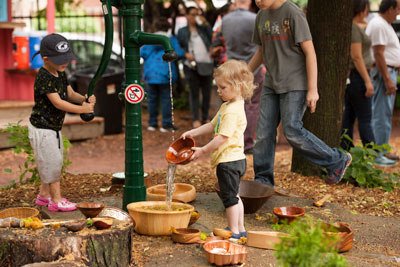
As if to prove this point, Chicago’s McKinley Park Community Play Garden, designed by Site Design Group around the concept of discovery play, is maintained by community volunteers. The park features a “kitchen” with pots and pans for making mud pies, along with a water pump that requires a cooperative effort to operate. “So, instead of a traditional playground where you have one kid on the monkey bars, you have kids working together to pump water and haul mud from the pit,” Ishikawa said.
Then, they can express their individuality by creating mud sculptures, often embedded with leaves, acorns and other objects. “It’s really about letting kids be hands-on and shape their environment instead of having something stationary,” Ishikawa said.
Multipurpose and Multigenerational Design Invites More People to Connect
The popularity of cooperative play underscores the second of Nesbitt’s drivers of park landscape design: the need for social connection. For as much as the COVID-19 pandemic left people feeling isolated, it also caused them to “recapture the public realm and community outdoor space” for safe assembly, she said.
Social functions that previously took place in churches, community centers and other enclosed spaces moved to parks during COVID, and park design must adapt to accommodate a wide range of activities and age groups.
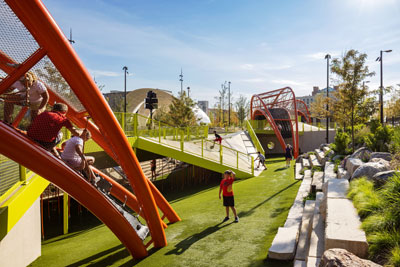
“Accessibility, inclusivity and flexibility are key,” Crawford said. “Parks need to be places where anyone and everyone—no matter how old or young they are, no matter what their abilities or limitations might be—has access and feels welcome.”
Inclusivity and accessibility were prioritized in park design long before COVID, but the need to incorporate multipurpose spaces and flexible programming became more apparent as park use increased during the pandemic. “It used to be that parks might offer a very simple, open-air pavilion that people could reserve or rent if they wanted to have a birthday party or a family reunion,” said Crawford, adding that these small gatherings were typically content to throw some burgers on the grill. “Now, large groups show up for all kinds of events, and they’ve got 30 crockpots with food that they want to plug in and keep warm. So now we’re installing permanent countertops that have electrical outlets. That’s just one very simple way we’ve responded to programming needs.”
The pandemic gave rise to “a lot of user-created programming and spontaneous meetups, so parks need multipurpose spaces” for activities as varied as Qigong and costume contests for pets, Nesbitt said. “Parks need to have these flexible, open spaces that enable the community to activate programming in a wide variety of ways. People get on their phones and organize a ‘Mommy and Me’ meetup, for example, so you get these clusters of social groups coming, and they need public space to host whatever little event they want to do.”
Accommodations that meet those diverse needs might include “big, open plazas, stroller parking, park edges that are hardscaped and have electrical outlets to power food trucks, small stages for impromptu or programmed performances … the list goes on,” Nesbitt said.
In response to this need to connect people socially, Bonnet Springs Park includes several gathering facilities, including an event center, banquet hall and a large expanse of lawn for festivals. Smaller, more intimate gathering spaces on the site include a treehouse and a tea house. “The range of activities in the park supports physical and social equity for all visitors in an effort to reinforce shared experiences and forge new connections,” according to the park’s website.
Regardless of a park’s size, “you need to think about inclusion and multigenerational appeal and ensure there’s a spectrum of opportunities, whether it’s quiet, secluded little areas that offer an escape from sensory overload or highly active places where teens come together,” Cawrse said.
Using Fiscal Resources Responsibly and Creatively
When it comes to park design, programming and maintenance, one common theme applies “pretty much across the board, regardless of the park agency’s size or whether it’s publicly funded, privately funded or a combination of both—they’re all faced with the same challenge of trying to do more with less funding,” Crawford said.
Over the past two decades, Crawford has seen a steep increase in public-private partnerships and reliance on grant funding.
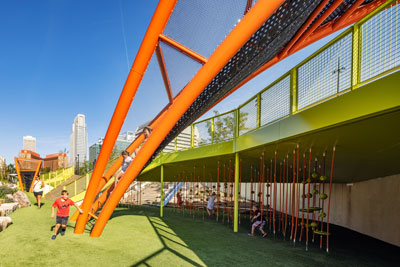
Involving public donors and corporate investors in park design “isn’t brand new in park creation,” Nesbitt said, “but it feels like it’s becoming more mainstream as a means of enabling parks to be sustainable over time.”
So, too, is the acceptance of parks as “revenue generators that help pay for themselves by hosting ticketed events,” although free admission and offering events that are free and open to the public is still considered imperative, she added.
Sometimes, the need to conserve financial resources ends up complementing the need to protect natural resources—for example, when clients tell Crawford “right out of the chute” that they don’t want to maintain turf grass or shrubbery and so they opt for a lower-maintenance plant palette instead, thereby reducing irrigation and chemical applications.
Needs-driven or human-centered park landscape design benefits the planet, but its principle goal is to improve the community. As such, the community engagement phase of park planning has become more influential, so much so that Crawford calls it an act of “co-creation,” with public input guiding every decision.
While still employing traditional methods like town hall meetings and surveys, park design firms are also leveraging technology and other types of forums to determine a community’s wants and needs. “We’ve actually gone into elementary schools and shown kids visuals of different playground elements and activities so they can vote on the ones they like most,” Crawford said. “Sometimes, the presentation is done digitally, but other times we’ll post pictures and give them stickers so they can mark their preferences.”
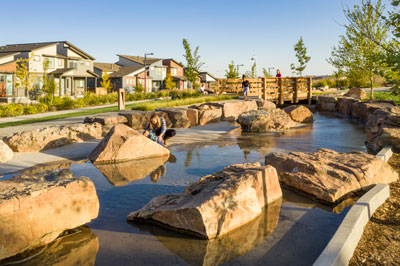
Coming out of the pandemic, people had become accustomed to virtual meetings—a format that helps rather than hinders community involvement in park planning. “Public meetings that happen in person tended to exclude a lot of people,” Nesbitt said, whereas conferencing software allows folks to comment on design proposals from anywhere, ensuring that a community’s “divergent voices are reflected in our creation process.”
Posting QR codes at the site of a future park allows people to make comments and answer survey questions “while they’re in the space at that moment,” which offers a better sense of the site’s potential.
Certain grants have specific outreach, engagement and language access requirements, including traditional, digital and grassroots communications (such as door-to-door canvassing).
Co-creation is so critical to the design process that Crawford estimates that outreach and engagement efforts make up half of master-planning. “If the overall masterplan has 100 things that need to get done, easily 40 to 50 of those things involve some form of public engagement, and the other 40 or 50 things relate to the actual design,” he said. And that second part can’t commence until the first part provides a full picture of “what the community needs are for that park and how they expect they’ll use it once it’s built.” RM



